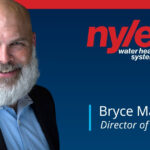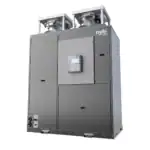Why Cold Climate Heat Pumps?
Heat pump water heaters have become a leading choice for commercial applications looking to reduce energy costs and carbon emissions. But not all heat pumps perform the same in cold temperatures. If you're in a region with freezing or extreme cold conditions, choosing the right system can mean the difference between reliable heating and system failures in winter.
Why Cold Climate Performance Matters
Commercial heat pump water heaters work by extracting heat energy from outdoor temperatures (ambient air) to heat water efficiently. But as temperatures drop, many systems struggle to maintain efficiency—or even shut down. In cold climates, it's essential to choose a heat pump that operates efficiently at low temperatures to ensure a constant supply of hot water, minimize energy use, and lower carbon emissions.
Key performance factors include:
Minimum operating temperature
Very few products produce high temp water down to 10°F, while most others falter or shutdown at 24°F or higher.
Defrost strategy
Inefficient defrost cycles can cause heat loss, requiring more energy and leading to inconsistent hot water supply.
Freeze protection measures
A system that not only prevents catastrophic failure in freezing conditions but also in the event of power failure while minimizing operator involvement is essential to providing reliable commercial domestic hot water in cold climates.
The Problem with Standard Heat Pumps in Cold Temperatures
Many standard air-source heat pumps are not optimized for sub-freezing temperatures. When outdoor temperatures drop, some units prioritize defrosting over heating, meaning:
- Hot water production slows or stops.
- Heat is taken from storage tanks and dumped outside, leading to cold water returns.
- Stratification in the storage tank is disrupted, leading to more energy waste.
- The compressor runs harder, reducing lifespan and efficiency.
Some recently introduced commercial cold climate heat pumps claim to perform well in cold temperatures, but their real-world efficiency tells a different story.
Example:
A new popular heat pump model lists its heating capacity at 40°F but struggles below 24°F. It also runs defrost cycles so frequently that little heat is produced. In contrast, Nyle’s e360 heat pumps operate efficiently down to 10°F and even provide performance inclusive of defrost, ensuring consistent and reliable heating even in extreme cold.
Additionally, some systems rely on backup heating sources such as electric resistance elements or gas furnaces, which can significantly increase energy consumption and operating costs.
Key Features of a Cold Climate Heat Pump for Extreme Cold
To ensure reliable heating and efficiency in cold weather, look for these features:
Low-Temperature Operation
The best units function efficiently at or below 10°F, ensuring reliable heating even in extreme cold conditions.
Smart Defrost Management
Avoid systems that continuously cycle into defrost mode and look for options that maintain consistent heating even in lower outdoor temperatures.
Efficient Freeze Protection
A well-designed heat pump will prevent freezing without dumping cold water into storage tanks, preserving system efficiency and preventing unnecessary supplemental heat usage.
Multi-Voltage Compatibility
Units that support 208V, 240V, and 460V provide greater flexibility and avoid unnecessary power inefficiencies.
Serviceability & Support
Choosing a system that is easy to install, maintain, and service ensures long-term reliability. Look for units designed with integrated components and factory-trained support teams.
Coefficient of Performance (COP) Awareness
High-efficiency heat pumps are designed with high COP ratings that include supplemental energy draws like fan power for ducted applications, pump power, power transformers, and heat transfer inefficiency from secondary heat exchangers and glycol. This maximizes heating capacity while minimizing energy consumption, and is crucial for maintaining performance in cold temperatures.
Smart Defrost and Supplemental Heat Logic
Frost buildup is inevitable when outdoor coils operate below freezing or in mild ambients with high humidity. But how your system handles it can make or break cold-climate performance.
High-quality commercial heat pumps use logic-driven defrost cycles to efficiently melt ice on the outdoor coil—without disrupting heating or wasting energy. These systems monitor coil temperature and runtime to determine exactly when a defrost cycle is needed, rather than cycling in and out unnecessarily.
In some systems, the heat pump reverses its operation briefly to send warm refrigerant through the outdoor coil. This can steal heat from your storage tanks and cause indoor temperature drops.
Other systems, like Nyle's, use ER elements to efficiently melt the ice without interfering with the refrigerant cycle.
Equally important is how supplemental heat is used. In cold conditions or during defrost, many systems rely on electric resistance heaters. While necessary in some applications, overusing this backup heat negates energy savings and increases costs. The best systems are designed to minimize reliance on resistance heat, using it only when absolutely needed and in the most efficient way possible.
Nyle’s cold climate models—like the e360—are built with these controls in mind, providing consistent hot water even in sub-freezing conditions with minimal defrost interruption and highly efficient use of backup heat when required.
The Future of Heat Pumps in Cold Climates
With increasing regulations pushing for electrification and decarbonization, heat pump water heaters are rapidly replacing fossil fuel-based heating systems in commercial applications. However, choosing a heat pump that can handle cold temperatures is critical to avoiding system failures, excessive defrost cycling, and long-term inefficiencies.
Investing in a cold-weather optimized heat pump ensures:
- Reliable heating year-round
- Lower energy consumption and emissions
- Longer equipment lifespan
Heat pump manufacturers are improving their technology to meet the demand for higher heating capacity and cold-climate performance. Some models require supplemental heat or backup heating to function in even mildly cold ambient temperatures. Most of Nyle’s heat pumps minimize reliance on auxiliary heating, ensuring better energy efficiency and lower operating costs.
Using a heat pump system can reduce your carbon footprint and improve energy efficiency. Be sure to choose one that provides reliable heating even in cold conditions.
Don’t be Left out in the Cold: Choose the Right Heat Pump System
Cold climate performance is a key differentiator in heat pump technology. Not all systems are created equal. Selecting the right one can mean the difference between a reliable, money-saving system and costly repairs and energy usage.
Some newer heat pumps on the market promise strong cold-weather performance, but real-world data shows they struggle at lower temperatures, frequently running defrost cycles and requiring additional backup heating. Nyle's cold climate heat pump, the e360, is designed for maximum efficiency in cold climates, making it one of the best options for commercial use.
When evaluating heat pumps for your commercial project, prioritize efficiency, defrost strategy, and low-temperature operation to maximize performance and long-term savings.











